Iqaluit, Nunavut 作者: 来源: 发布时间:2021-12-07
I.Population and Area
-Area
Land: 52.50 km2 (20.27 sq mi)
-Population (2016)
Total: 7,740
Density: 150/km2 (380/sq mi)
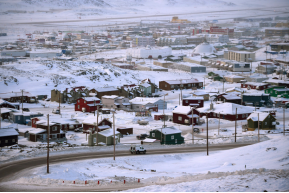
II.Natural Geography (environment and resources)
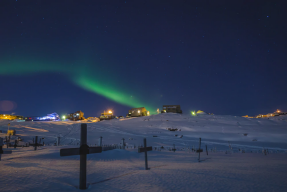
-Iqaluit is the capital of the Canadian territory of Nunavut, its largest community, and its only city. It was known as Frobisher Bay from 1942 to 1987, after the large bay on the coast of which the city is situated. In 1987, its traditional Inuktitut name was restored.
-In 1999, Iqaluit was designated the capital of Nunavut after the division of the Northwest Territories into two separate territories. Before this event, Iqaluit was a small city and not well known outside the Canadian Arctic or Canada, with population and economic growth highly limited. This is due to the city's isolation and heavy dependence on expensively imported supplies, as the city, like the rest of Nunavut, has no road, rail, or even ship connections for part of the year to the rest of Canada. The city has a polar climate, influenced by the cold deep waters of the Labrador Current just off Baffin Island; this makes the city of Iqaluit cold, although it is well south of the Arctic Circle.
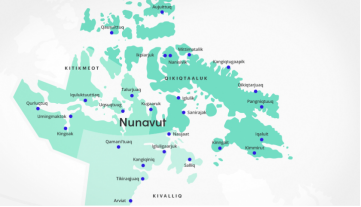
-As of the 2016 census, the population was 7,740 (Population Centre: 7,082), an increase of 15.5 percent from the 2011 census. Iqaluit has the lowest population of any capital city in Canada. Inhabitants of Iqaluit are called Iqalummiut (singular: Iqalummiuq).
-Iqaluit is located in the Everett Mountains rising from Koojesse (Kuujussi) Inlet, an inlet of Frobisher Bay, on the southeast part of Baffin Island. It is well to the east of Nunavut's mainland, and northeast of Hudson Bay.
-Climate
-Iqaluit has a tundra climate, featuring long, cold winters, and brief summers that are too cool to permit the growth of large trees.
-Iqaluit has a tundra climate (Köppen: ET) typical of the Arctic region, although it is well outside the Arctic Circle. The city features very long, cold winters and brief, cool summers. Average monthly temperatures are below freezing for eight months of the year. Iqaluit averages just over 400 mm (16 in) of precipitation annually, much wetter than many other localities in the Arctic Archipelago, with the summer being the wettest season. Temperatures of the winter months are comparable to other northern communities further west on the continent such as Yellowknife and to some extent even Fairbanks, even though Iqaluit is a few degrees colder than the latter. Summer temperatures are, however, much colder due to its easterly maritime position affected by the waters of the cold Baffin Island Current. This means that the tree line is much further south in the eastern part of Canada, being as southbound, in spite of low elevation, as northern Labrador.
-Although it is north of the natural tree line, there are some short, south-facing imported black spruce specimens protected by snow drifts in the winter, in addition to a few shrubs, which are woody plants. These include the Arctic willow (Salix arctica), which is hard to recognize as a tree because of its low height. The Arctic willow may be up to around 7.6 m (25 ft) horizontally, but only 150 mm (6 in) tall.
-The climate of Iqaluit is also colder than Gulf Stream locations on the same latitude. For example, the Norwegian city of Trondheim has an annual mean temperature that is 16 °C (29 °F) milder.
-The highest temperature ever recorded in Iqaluit was 26.7 °C (80 °F) on 21 July 2008. The lowest temperature ever recorded was −45.6 °C (−50 °F) on 10 February 1967.
III.ECONOMY
-The average salary in Iqaluit, Nunavut is C$76k.
-The average salary in Iqaluit, Nunavut is C$76k. Trends in wages decreased by -100.0 percent in Q1 2020. The cost of living in Iqaluit, Nunavut is 100 percent higher than the national average. The most popular occupations in Iqaluit, Nunavut are Retail Store Manager, Elementary School Teacher, and Electrician which pay between C$42k and C$142k per year. The most popular employers in Iqaluit, Nunavut are Government of Nunavut, Baffinland Iron Mines, and Agnico-Eagle.

-Website: https://www.payscale.com/research/CA/Location=Iqaluit-Nunavut/Salary
IV.Industrial Characteristics
-The main industries in Nunavut include arts & crafts, mining, fishing and hunting and trapping. Nunavut is known worldwide for prints and carvings. Mineral exploration and mining are growing industries, but the high cost of travelling to the territory, as well as bringing materials to Nunavut, are a challenge.
-Mineral Exploration and Mining
-The development of mineral and petroleum resources has the potential to generate significant economic benefits for Nunavut. Over the past few years, Nunavummiut have benefited significantly from mine exploration, development and gold production.
-In 2011, the cost of mineral exploration reached over $300 million as gold, diamond and base metal deposits were and continue to be explored throughout Nunavut. In 2011, 270,801 ounces of gold were produced at the Meadowbank mine at a market value of approximately $420 million.
-Traditional Harvesting
-In addition to the formal economy, Nunavut also has strong traditional sectors of hunting, which continues to play a significant role in Nunavut’s economy.
-Nunavut’s economy is historically based on the harvesting traditions of its Inuit, who continue to maintain strong ties to the land. Harvesting animals provides meat for food; fur and skin for clothing; and bones for tools, games and art. A recent study estimated the current harvesting economy is worth approximately $40 million annually. Sealing in Nunavut is not just an industry, it is a lifestyle that helps keep Inuit close to their natural environment. An estimate of over 40,000 seals are harvested per year in Nunavut. The replacement food value of seal meat is worth approximately $5 million. Seal skin products are worth an additional $1 million to the arts and crafts sector.
-Fisheries
-Nunavut has established commercial turbot, shrimp, and char fisheries that offer global markets access to a unique range of products. The on and offshore turbot fishery is a major employer in the Baffin region. For turbot, Nunavut has an offshore quota allocation of over 9,500 metric tonnes, which had a landed value of approximately $70 million in 2011. For the same year, only 60 metric tonnes of turbot were caught of the 500 metric ton onshore quota. With improved ice conditions this year, local fisheries are expecting to meet the entire 500 metric tonne quota. With much of its commercial fishing stock still unexplored, fisheries provides an important and growing contribution to the territory’s economy. With funding support from the federal government, the Government of Nunavut (GN) recently purchased an advanced research vessel—the Nuliajuk—that allows scientists to collect information on marine species, habitat, and populations in waters adjacent to Nunavut.
-Tourism
-The unique Inuit culture and the outstanding natural beauty of Nunavut continues to attract tourists from around the world. An estimated 14,000 people visit Nunavut annually. The range of tourism activities includes eco-tourism, sports hunting, fishing, cultural, adventure and educational activities.
-Nunavut’s four national parks and 15 territorial parks present another opportunity for visitors seeking to explore the territory’s extraordinary beauty. Nunavut’s parks include campgrounds and are a major tourist attraction. Cruise ships now visit Nunavut communities annually providing an important source of income for many residents through art sales.
-Inuit Art
-The production of Inuit art continues to play an important role in the economies of many of Nunavut’s communities. Departmental studies found the arts and crafts sector contributes approximately $33 million to the territory’s economy. Many of the territory’s artists have received international recognition. While most Canadians are familiar with soapstone carvings and prints from communities such as Cape Dorset and Baker Lake, internationally recognized tapestries and weavings are being produced in Pangnirtung.
-Nunavut artists are rapidly making a name for themselves in film, broadcasting, and new media; the international success of films such as “The Necessities of Life” and “Atanarjuat – The Fast Runner” highlights both the talent of Nunavut’s resident producers, and the visually attractive landscape of Nunavut as a venue for film production.
-Website: https://www.gov.nu.ca/eia/documents/nunavut-economy
V.Attractions
1.Nunatta Sunakkutaangit Museum

-Located in Iqaluit, the capital of Nunavut, Nunatta Sunakkutaangit is the only museum in the territory. The museum is a not-for-profit organization that preserves and promotes local culture and art. Housed in an old Hudson’s Bay Company storage building, the museum offers a permanent gallery of Inuit artifacts and art and a temporary gallery of exhibitions of contemporary art. The museum also offers a unique museum shop with latest work of local artists.
-Telephone: 867.979.5537
-Email: museum@nsmuseum.ca
-Website: https://www.nunattasunakkutaangit.ca/home
2.St. Jude's Cathedral
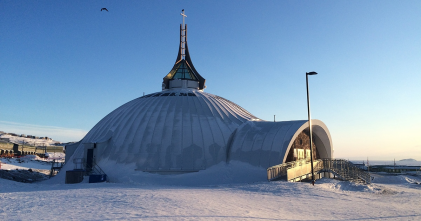
-St. Jude's Cathedral (formally the Cathedral of St. Simon and St. Jude) is the Anglican cathedral in Iqaluit, Nunavut, Canada. The cathedral is the seat of the Diocese of The Arctic, which covers the Northwest Territories, Nunavut, and the Nunavik region of Northern Quebec. It has the greatest area of any Anglican diocese in the world. The cathedral is also the parish church for the parish of Iqaluit and holds services in English and Inuktitut.
-The original St. Jude's Cathedral had been designed by Ronald Thom in 1970 and built in 1972 by local volunteers. It was well known for its decorations, most the product of Inuit craftsmanship; these included wall hangings, woven collection baskets, a cross made of narwhal tusks, and a carved soapstone baptismal font dedicated by Elizabeth II, Queen of Canada, during a visit to Iqaluit.
-The first St. Jude's Cathedral was demolished in June 2006 after an arson fire in November 2005 destroyed much of the structure.
-The current building, informally referred to as the Igloo Cathedral, was opened on June 3, 2012. The unique building, in the shape of an igloo, has traditionally been a landmark and tourist attraction in Iqaluit, besides its important spiritual role for Iqalummiut (people of Iqaluit).
-Address: 655 Mattaaq, Iqaluit, NU X0A
-Phone: (867) 979-5595
-Website: https://www.atlasobscura.com/places/st-jude-s-igloo-cathedral
3.Inukpak Outfitting inc.
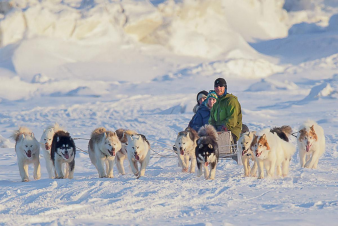
-Inukpak (in Inuktitut, the Inuit language) means the gentle giant; it should make sense when you’ll meet the company founder. Since 2011, we are pleased to offer guided services in the Nunavut Capital, Iqaluit. Our main goal, designing products to meet “your” expectations and creating an experience of a life time. Safety, public-at-large oriented, client needs, Inuit culture and environment are our main concerns. Specialized in dog sledding, we are also offering other products such as: snowmobiling, ice fishing, hiking, canoeing, kayaking and many more.
-Specializing in dog sledding, INUKPAK OUTFITTING offers a wide range of amazing guided services, such as snowmobiling, snow sailing, hiking, canoeing, sea kayaking and much more. Whether you are looking for a half-day adventure or a multi-day Arctic expedition, whether you’re a beginner or a seasoned outdoor enthusiast, whether you’re looking for a peaceful adventure or a challenge to match your skills, we have everything you need, from head to toe! All our programs are offered as “turnkey solutions”.
-With close to 20 years of guiding experience, an in-depth knowledge of the Arctic, combined with the strength of a polar bear and a friendly smile surrounded by a frozen beard, Louis-Philip welcomes you to his world: the great Canadian Arctic! In the company of this certified professional guide, wilderness first responder and “Active Guide” member of the AGPTA (Adventure Tourism Professional Guide Association), you know you’re in good hands.
-Louis-Philip manages Inukpak Outfitting from his office and out on the land with his guests. You might have seen him teach a wide variety of land and survival skills such as orientation/GPS, Arctic survival, or swift water rescue; he is also a trainer from the Leave No Trace Canada Association, and a certified Avalanche Safety Trainee, with the Canadian Avalanche Association.
-In addition to Inukpak Outfitting, Louis-Philip works as an Instructor for Sirius Wilderness Medicine, teaching all levels of ‘’Wilderness First Aid“.
-At home, he is a proud “papa” of 3 young adventurous explorers and maybe (in his greatest dreams!) 3 future great Inukpak Outfitting guides!
-Address:
3310 Niaqunngusiariaq street
P. O. Box 11392
Iqaluit, Nunavut
X0A 1H0, Canada
-Phone: (867) 222-6489
-Website: https://inukpakoutfitting.ca/en/contact-us
VI.History
-Iqaluit has been a traditional fishing location used by Inuit for thousands of years. The name, Iqaluit, comes from Inuktitut Iqaluit (ᐃᖃᓗᐃᑦ) which means place of many fish.
-World War II resulted in an influx of non-Inuit to the area, as Canada and the United States cooperated in the defence of Europe. In 1942, the United States built an American air base there, on a long-term lease from the Canadian government, in order to provide a stop-over and refuelling site for the short-range aircraft being ferried to Europe to support the war effort. Iqaluit's first permanent resident was Nakasuk, an Inuk guide who helped US Army Air Force planners to choose a site with a large flat area suitable for a landing strip. The wartime airstrip was known as Crystal Two and was part of the Crimson Route.
-It had long been used as a campsite and fishing spot by the Inuit, who called it Iqaluit – "place of many fish" in Inuktitut. The US and Canadian authorities named it Frobisher Bay, after the name of the body of water it borders. For the history of the air base, see Frobisher Bay Air Base.
-In 1949, after the war, the Hudson's Bay Company moved its south Baffin operations to the neighbouring valley of Niaqunngut, officially called Apex, in order to use the airfield. In the mid-1950s, the population of Frobisher Bay increased rapidly during the construction of the Distant Early Warning Line (DEW line, a system of defensive radar stations—see North American Aerospace Defense Command (NORAD)). Hundreds of mostly non-Inuit construction workers, military personnel, and administrative staff moved into the community, and several hundred Inuit followed, to take advantage of the access to jobs and medical care provided by the base operations. By 1957, 489 of the town's 1,200 residents were reported to be Inuit. After 1959, the Canadian government established permanent services at Frobisher Bay, including full-time doctors, a school, and social services. The Inuit population grew rapidly in response, as the government encouraged Inuit to settle permanently in communities supported by government services.
-Naval Radio Station (NRS) Frobisher Bay, callsign CFI, was established in July 1954 as a result of the closure of NRS Chimo, Quebec. Station CFI was part of the Supplementary Radio network. Because of its remoteness and size, it was very expensive to operate. Advancing technology eventually forced the closure of CFI in 1967.
-The American military left Iqaluit in 1963, as their development of the intercontinental ballistic missiles (ICBM) diminished the strategic value of the DEW line and Arctic airbases. Canada continued to operate an administrative and logistical centre for much of the eastern Arctic at Frobisher Bay. In 1964, the first local elections were held for a community council, and in 1979 for the first mayor. The founding of the Gordon Robertson Educational Centre, now Inuksuk High School, in the early 1970s at Iqaluit confirmed the government's commitment to the community as an administrative centre. At the time of its founding, this was the sole high school operating in what constituted more than one-seventh of Canadian territory.
-On 1 January 1987, the name of the municipality was changed from "Frobisher Bay" to "Iqaluit" – aligning official usage with the name that the Inuit population had always used. (Many documents were made that referred to Iqaluit as Frobisher Bay for several years after 1987). In December 1995, Iqaluit was selected by a territory-wide referendum to serve as Nunavut's future capital; it was chosen over Rankin Inlet. On 19 April 2001, it was designated a city.
-Canada designated Iqaluit as the host city for the 2010 meeting of the G7 finance ministers, held on 5–6 February. The requirements for the international meeting strained the northern communications technology infrastructure and required supplemental investment.
VII.Other information
-The long term goal of the Community Infrastructure division is to provide all communities in Nunavut with a full complement of basic and supporting infrastructure. This will allow communities to become self-sufficient as well as economically, socially and culturally prosperous.
-The mandate of the Community Infrastructure division is to secure and allocate funding for community infrastructure projects. The division must do so in an equitable, fair and transparent manner, balancing community needs and regulatory requirements while working with stakeholders and partners in the communites as well as Federal, Provincial and Territorial levels of government.
-The division achieves its goals through the capital planning process, which ensures that critical infrastructure gaps are identified, priority projects are brought to the forefront and essential infrastructure is provided for each community. The NCIAC (Nunavut Community Infrastructure Advisory Committee) provides oversight for projects funded through the Gas Tax fund.
-Website: https://www.gov.nu.ca/infrastructure-and-technical-services
VIII.Contact information
-Government
Governing body: Iqaluit City Council
Mayor: Kenny Bell
-Town Hall
-Telephone: (867).979.5600
-Mail: Building 901, City of Iqaluit, Box 460, Iqaluit, Nunavut, X0A 0H0
-Fax: (867) 979.5922
Website: https://www.iqaluit.ca/complaints-and-compliments
